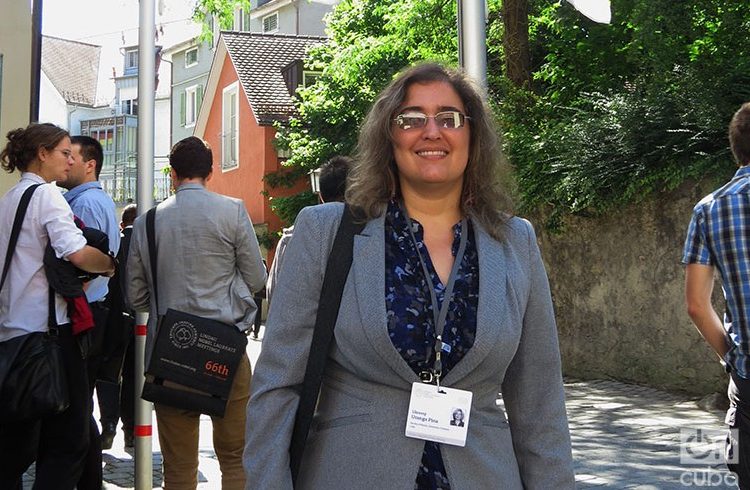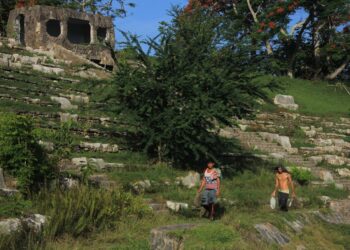That they invited Llinersy to the World Meeting of Nobel Laureates in the German town of Lindau, took her by surprise. When they confirmed that she could attend, she could not believe it. Llinersy Uranga, a quantum physics scholar and professor at University of Havana’s Physics Faculty, is a modest young woman who avoids talking about her not insignificant personal achievements as much as possible.
She has the Young Scientist Award for outstanding research awarded by the Caribbean Academy of Sciences and the Academy of Sciences of the Third World (CAS-TWAS for its English acronym), a distinction which meant that she was automatically nominated to attend the prestigious event in the Bavarian city.
Unlike other countries, Cuba has only appeared three times in the list of participants in the 66 meetings that have so far have taken place in Lindau. A figure that according to Uranga is due to the lack of information about the event in Cuban scientific community.
“I would be lying if I said I knew about this meeting,” she confesses to OnCuba at the beginning of the interview that took place in one of the conference rooms of StadtTheater or City Theater, a building of medieval origin and these days a home to a high percentage of conferences, roundtables, readings and talks.
“The Cuban Academy of Sciences, as in all countries, has the opportunity to nominate outstanding young scientific researchers. But it is little-known information,” insists the young researcher.
The Cuban institution is registered within the academic partners of the event and thanks to this status can in effect nominate any Cuban youth under 35 years, fluent in English, who is studying at an undergraduate, doctoral or post-doctoral level and has an excellent academic career in the field of physics, chemistry and medicine.
“It is unbelievable being here – says Llinersy – because you can exchange ideas with many young scientists who have another perspective of the research being conducted in the world, and so you can be updated on what is being done and offer new ways of seeing research that you are doing. It also opens up possibilities for collaboration, and, very importantly, you acquire the experience of the Nobel Prize winners, who more than anything else you to continue with your work and to do things that actually help level your country or region.”
Part of her research in theoretical physics have led her to immerse herself in, among others, quantum dynamics in molecular systems of many objects of many bodies and to dream of the application of these and other investigations in order to obtain, for example, an effective way of store hydrogen content in the water and use it for power generation.
During this recent event Llinersy found discussions that dealt with her subjects of study. Many of the scientists who developed the models upon which she incurs attended.
“This meeting has the possibility that you have different branches of, in this case, physics, that can contribute to your own research because there are methods that can be applied to you work and you widen your view of the area in which you work and in others that you would like to work in eventually.”
The presence of more than twenty Nobel laureates, including the professors Takaaki Kajita (Japan) and Arthur McDonald (Canada), awarded in 2015 the Nobel Prize in Physics for their pioneering study of neutrinos, or the American physicist William D. Phillips, winner of the highest prize in 1997 due to developing of methods to cool and trap atoms with laser beams, for the more than 300 young people present presented a unique opportunity and, as Dr. Uranga noted, a challenge.
“This year for example – says Uranga – one of the attendee is the Japanese professor Hiroshi Amano, who was awarded the Nobel Prize in 2014 for discovering the operation of the LEDS, an invention that will revolutionize energy consumption worldwide. This is an example of a result of physical investigations and that has an impact on everyday life, “.
From the first meeting in 1951 the idea of building and strengthening ties between scientists from around the world was always clear. In fact at that time, in a post-war period, the event initiated by physicists Franz Karl Hein and Gustav Wilhelm Parade along with the Count of Wisborg, Lennart Bernadotte (owner of the Mainau island, headquarters of the Council and the Foundation that organise the meetings) became an act of reconciliation act between the prestigious European researchers that would then widen the scope of the meeting around the world.
The success of the idea has led to the founding of a newspaper, alternately dedicated to Nobel laureates in disciplines such as medicine, physics and chemistry. By 2004 the first additional Lindau Meeting in Economic Sciences, which saw the attendance of prominent figures as Reinhard Selten, awarded for his theory of non-comparative held games in 1994.
Thus the small, old German city on the shores of Lake Constance, would, every year in June, turn into the epicenter of intergenerational scientific dialogue. Moreover, this time the event had a singular fact: the Cuban Linersy Uranga lived that experience and carries with her the interest in connecting her island with this level of international science. It is not so impossible.










